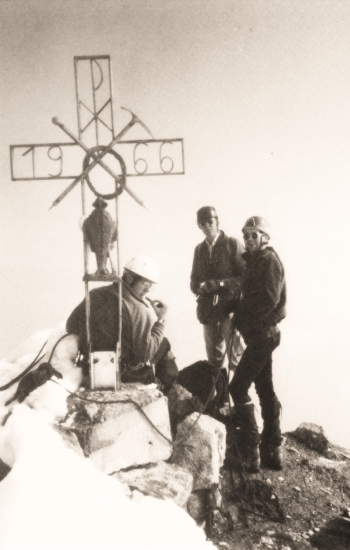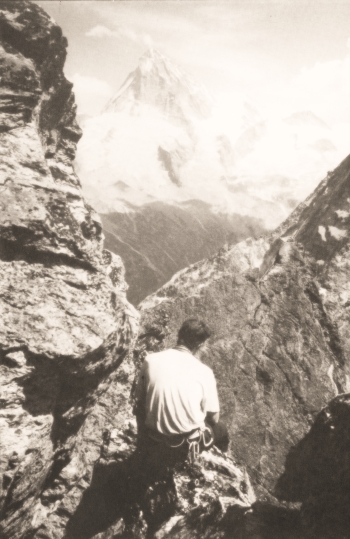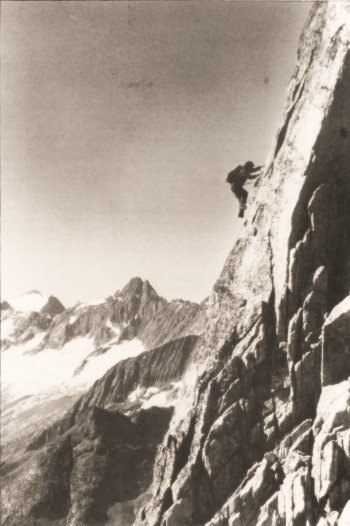Extracts From Alpine Meets
by F. D. Smith
The introduction of an annual Alpine meet to the YRC calendar may beafactor in the membership’s increased interest in climbing and serious mountaineering. Described in the handbook as an “open meet”, they can be attended by members’ families and have enabled those members, who would otherwise have difficulty in attending, to be present. A further gratifying aspect of the meets has been the introduction of young members to high mountains with the support of older members.
Each Alpine meet overthe past six years has been fully reported and the following two articles are representative of the period.

The Ascent Of The Dent Blanche By John Devenport
Since a failed attempt to ascend the Dent Blanche on a previous YRC meet in the Val d’Herens in 1986, in my mind, its size had decreased and its slopes had become less steep, so I was in for a rude awakening, as I drove up the valley from Sion to join this year’s Alpine meet and turned a corner to seethe bulky shape of the Dent Blanche totally dominating the end of the valley, looking very high and very, very steep!
In the second week of the meet, a group of seven (Peter Chadwick, Mike Smith, Jonathan Riley, Graham Salmon, David Smith, David Hick and John Devenport) set off from Ferpecle for the long walk up to the Rossier Hut, for this year’s attemptto ascend the mountain by the South Ridge (Wandflue Ridge). The latterthree had a previous attempt foiled in 1986 by a severe storm the night before. In blazing sunshine the party made good progress, passing through Bricola before reaching the extensive moraines at the edge of the Glacier des Manxettes. We were able to keep on rock for most of the way by keeping mainly below the glacier, before the initially steep ascent of the convex ice-slope leading to the Rossier Hut. On arrival at the hut, we were very pleasantly surprised to find it had been extended and totally refurbished, beautifully decorated throughout in new pine. Even the female guardian managed a smile this time!
After a mountain of spaghetti, the group retired to bed early, knowing that, whatever happened, tomorrow would be a long day on a big mountain!
After an early call at 4.30 and a speedy breakfast, we set out into the cool, clear night, with the stars shining brightly above the black shadow of the Dent Blanche looming above us. As soon as you leave the hut the way is tricky, as you quickly reach a very narrow rock arete, which comes too soon so early in the morning. After that, a steep snow arete leads uptoa broad, snow col at the Wandfluelucke (3703m), from where stunning early morning views across to the Matterhorn and Monte Rosa group are revealed. Here we turned left and started up the South ridge, crossing familiar territory; the broken, rocky ridge, then the traverse across the steep ice-slope with its enormous scoop and large cornices, leading up to the main ridge proper. We were moving well in ropes of four and three, and before long we were at the foot of the Grand Gendarme, turning it on the left via the couloir, which is partly filled with snow (and caused us so many problems last time with its verglassed, sloping slabs!). The ridge was quickly regained and before long we were making more good progress, winding our way past the many rocky obstacles along the ridge, some small, some very large. Surprisingly soon we were atthecruxof the ridge, which involved an awkward move round an exposed corner followed by vertical wall (10m of II+). I was elated after climbing this, as it was Where we had turned back last time.
By now, cloud had gathered around the ridge, somewhat restricting visibility, but the angle of the ridge started to decrease, indicating that we were nearing the summit. Our rope of three met the other rope of four, as they appeared out of the mist on their descent from the summit, which they indicated was about 20 minutes away. As we passed, with a smile on his face, David Smith said to me, “I think you’ll make it this time, John”, which was wonderfully encouraging. Surprisingly, aboutten minutes later, we were walking carefully along the exposed summit ridge with a crucifix at the end. It was quite a moving moment, as the three of us congratulated one another in the swirling mist.

We hung around for about half an hour, taking photographs, hoping that the mist would clear to reveal the surrounding peaks, but it never did. So we set off back down, after taking about five hours for the ascent.
Things went fairly well to begin with, but then we were held up above the Grand Gendarme by other parties queuing/pushing past us inconsiderately and dangerously to use the abseil points. Atone point we caught up with the other four in our party. By now the weather was taking a turn for the worse, and before long we were in a severe hailstorm as we descended the ridge. Things were getting decidedly unpleasant, as the large hailstones stung our hands and necessitated putting a cagoule on for the first time in the holiday! We went as quickly as possible, though it was taking us ages, but eventually we were crossing the scooped snow slope and then descending the snow arete to the last rocky ridge, made very tricky by the rain which was now falling at the lower altitude. Eventually the welcoming sight of the hut roof appeared out of the mist a short distance below us at about 5.45pm.
By the time we reached the hut, the other four in our party had already set off back down to the valley and, after a quick drink at the hut, we too set off into the inclement weather, in order to get down to the valley before dark. Surprisingly, the weather cleared, and we had a very pleasant walk down in the warm glow of the evening sun. We arrived back at Ferpecle at about 9 pm, after a 14-hour day, very tired but very happy at having reached the summit of the Dent Blanche, and getting down safely.
The Aiguille Dibona by Jonathan Riley
The first time I saw the Aiguille Dibona was on the back of Paul’s guidebook the night before we set off to the Alps. A magnificent sight, more like a church steeple than a mountain.
Searching through the list of TD and ED routes, I thought that climbing it was merely a dream, until I saw the route called Voie Boell, graded AD. Translating AD (Assez Difficile) into a “real” British climbing grade revealed that it was only severe. From then on it had to be done.
A few days later, after some persistent persuasion, l had found three other “victims”, that is people silly enough to come with me, namely David Smith, Graham Salmon and John Devenport.
As always the approach to the hut was weighed down with big, overloaded rucksacks. We toiled upwards in the heat. The Dibona was hidden in mist, tempting us with only glimpses of her razor-sharp summit.
The Refuge Soreiller was practically empty, the omelette was enjoyed by nearly all and a good night’s sleep with no Alpine start was sheer luxury. Looking out of the hut at 7 am, expecting to find mist, only to find that the sun was out and the sky was bright blue, left us with mixed feelings of excitement, concern and uncertainty. What had the Dibona in store for us?
We left the hut and, after half an hour of scrambling over rocks and scree, exchanged our big boots for rock boots at the foot of the East face. Leading off up the first corner, I was shaking, though the climbing was easy. Only then did I understand how serious the mountain was. A first attempt at a real pitched Alpine rock climb, warm rock, rough granite and clear blue skies, perfect.
I traversed leftwards delicately under an overhang. Round the corner I cast my eyes on to the South face to where the exposure was intense. Sweeping granite faces terminated at the hut a long way down, while all around jagged Alpine summits looked on to us.
I perched on a huge flake, pondering if it was attached or not. As David climbed up to the flake, an Alpine guide and his clients glided effortlessly past up an even harder route. I attempted a confident smile: somehow I don’t think the guide was convinced!
David did not seem worried at all; he never is. We couldn’t see Graham and John, but continued by a wide ledge to the foot of a cold, enclosed corner, which offered respite from the exposure and provided easy climbing to a delicate and exposed traverse over a slab to another small chimney. Once up this we sat on the arete, watching the guide and his clients negotiate the next pitch. From what I could make out this was where the real climbing started. I was right!
In a fantastically exposed position I climbed up shallow, vertical finger-cracks to a notch in an overhang. A bold bridging move over thin air led to a large ledge and a short rest. Thank God!
Graham and John arrived on the arete, closely followed by yet another guide and his clients. As we set about hauling our vast rucksacks up the pitch, the guide was heard to say, “I just haven’t time to wait”, and with that he led up the pitch and emerged at the top. Grinning, he tapped his head and remarked about the stupidity of the English. This time I had to agree with him; the rucksacks were ridiculously large and heavy! David followed underneath the guide and did his bridging move facing outwards; it must be the classic method. He was followed by Graham who was impressed and John who was relieved!
We sorted the ropes and Graham set off on the next pitch. He was just above us when he exclaimed, “It’s delicate and there is a hole!” He was right, it was another bridging move from a friction foothold into a vertical crack, again over thin air and with a distinct lack of handholds! (Nice lead, Graham!) This led to a piece of artificial aid, a short rope-sling used as an initial foothold to gain , more vertical cracks on an apparently featureless slab, which led to easier pitches and finally the summit at a comparatively modest 3,130m.
All four of us were relieved and jubilant to be there at last. We drank, ate, posed for heroic photos and then abseiled for 150 feet down the North ridge to the Breche Gunneng to get off the top. We met our rescue party on the way down, who were under the impression that we must be having an epic, because we had not exactly done it in guidebook time. All was well but we were pleased to see them nevertheless.
My walk back down to the valley was spent thinking over the day, a climb which had tested nerve and concentration, but ended in triumph and jubilation, surely the essence of climbing.
A truly beautiful mountain!


